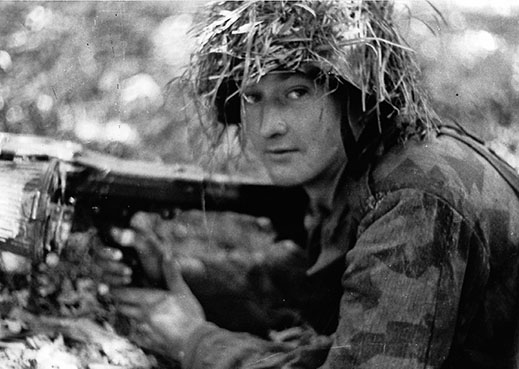
© Bundesarchiv
Choose your language ![]() Wähle deine Sprache
Wähle deine Sprache


Choose your language ![]() Wähle deine Sprache
Wähle deine Sprache
Poursuivre tout droit et descendre sur Brueil-en-Vexin jusqu’aux ateliers municipaux où se trouve le panneau (14) « La bataille de Brueil-en-Vexin. ».

During the American counterattack on August 28th, 1944, the plain in-between Brueil-en-Vexin and Sailly finds itself at the junction of the 79th and 30th Infantry Divisions, facing combat groups of the 18. Luftwaffen Feld Division.
Along the road known as Vétheuil’s, boarded by a hedge at the time, the Hauptmann Gohl of the 36 regiment had organized a line of defence: private wholes, machinegun positioning and anti-tank guns. After the storming of Saint-Laurent in the afternoon, the 117th Infantry Regiment of Colonel Johnson came out down below in the plain. In the path ‘Chemin aux Franches Terres,’ a well-hidden German company was waiting for the Americans. The two Obergefreiters Karl Stern and Helmut Volk, both aged 19, had taken position, climbed up in the trees on the edge of the woods. They were killed on the spot. Their bodies, hanging from the branches, were later buried on the edge of the road.
Where the road meets Guitrancourt’s, a 20 mm Flak gun sweeps the plain. In the background, at the crossroads of the chemin de la Croix Blanche, a “Pak 75” antitank drives along the road but its ammo truck has been hit and has exploded further down. The American reports mention: “German tanks in motion in the Vallée Danjon, southwest exit of Brueil-en-Vexin. The 283rd Infantry Battalion of US artillery shoots 72 105 mm shots. At 1 p.m., German backups come up: two motorized line infantries drive to Brueil-en-Vexin, while an artillery gun and a limber caisson are seen coming from Oinville-sur-Moncient. Despite this, the 1st battalion of the 117th Infantry Regiment of Lieutenant-colonel Frankland continues progression.”
At 4 p.m., the GIs collide with strong opposition from weapons of all calibres: “the enemy uses all the available weapons, including the DCA used with anti-tanks.” The C company of the 743rd Tank Battalion, along with about ten Shermans, should have taken part in the assault, but since the strong losses in Normandy, the Americans did not use their tanks in frontline anymore.

Während des amerikanischen Gegenangriffs am 28. August 1944 war die Tiefebene zwischen Brueil-en-Vexin und Sailly der Kreuzungspunkt, an dem die 79th und 30th Infantry Division auf die Kampfgruppen der 18. Luftwaffen-Feld-Division stießen.
Entlang des Weges von Vétheuil, der damals von einer Hecke gesäumt war, organisierte Hauptmann Gohl vom Regiment 36 eine Verteidigungslinie mit individuellen Löchern, Maschinengewehrstellungen sowie Panzerabwehrkanonen. Nach der Einnahme von Saint-Laurent am Nachmittag erreichte das 117th Infantry Regiment von Colonel Johnson schließlich von unten her die Ebene. Auf dem Weg Chemin aux Franches Terres hatte sich eine deutsche Kompanie gut versteckt und wartete auf die Amerikaner. Die Obergefreiten Karl Stern und Helmut Volk, beide 19 Jahre alt, waren auf die Bäume am Waldrand geklettert, um dort Position einzunehmen. Sie sollten an Ort und Stelle getötet werden. Ihre in den Ästen hängenden Leichen wurden später am Rand des Weges begraben.
An der Straßenkreuzung der Route de Guitrancourt stand eine 20 mm-Flak-Kanone, die über die Ebene hinwegfegte. Im Hintergrund, an der Kreuzung des Wegs Chemin de la Croix Blanche, nahm eine Panzerabwehrkanone „PaK 75“ die Straße unter Beschuss, jedoch wurde ihr Munitionswagen weiter unterhalb getroffen und explodierte.
In den amerikanischen Berichten heißt es: „Deutsche Panzerbewegung im Danjon-Tal, am südwestlichen Ausgang von Brueil-en-Vexin. Das 283rd Infantry Battalion der US-Artillerie feuerte 72 Schuss 105 mm-Kanonen auf sie ab. Um 13.00 Uhr kamen deutsche Verstärkungen, zwei motorisierte Infanteriekolonnen erreichten Brueil-en-Vexin, während ein Artilleriegeschütz und ein Kastenwagen mit Pferdegespann von Oinville-sur-Moncient kommend beobachtet wurden. Das 1. Bataillon des 117th Infantry Regiment von Oberstleutnant Frankland setzt trotzdem seinen Vormarsch fort.“
Um 16.00 Uhr stießen die GIs auf heftigen Widerstand durch Waffen aller Kaliber: „Der Feind setzt alle verfügbaren Waffen ein, einschließlich der Flak, die zur Panzerabwehr verwendet wird.“ Die C-Kompanie des 743rd Tank Battalion mit einem Dutzend Sherman-Panzern hätte an dem Angriff teilnehmen sollen, aber seit den hohen Verlusten in der Normandie setzten die Amerikaner ihre Panzer nicht mehr an der Frontlinie ein.



